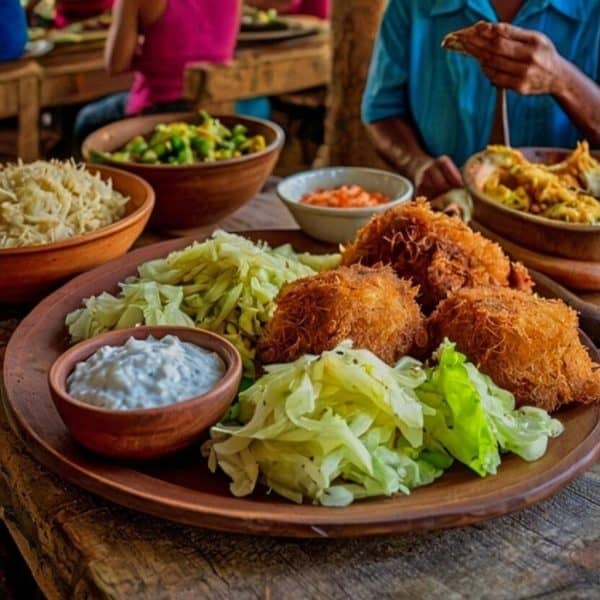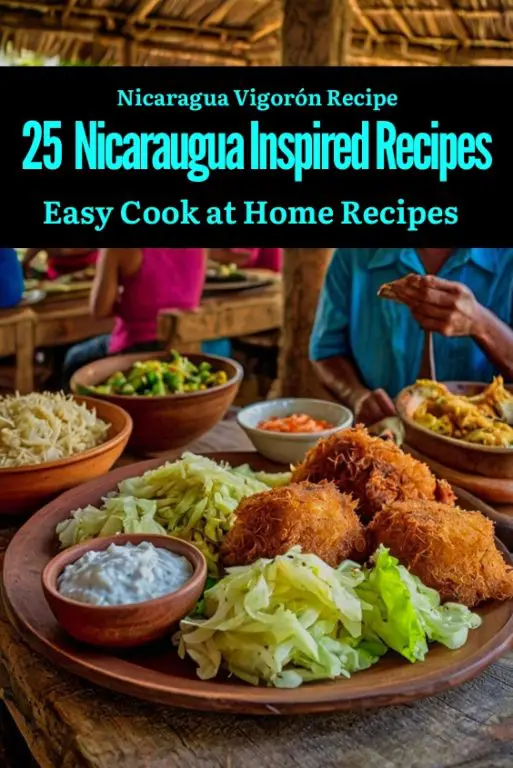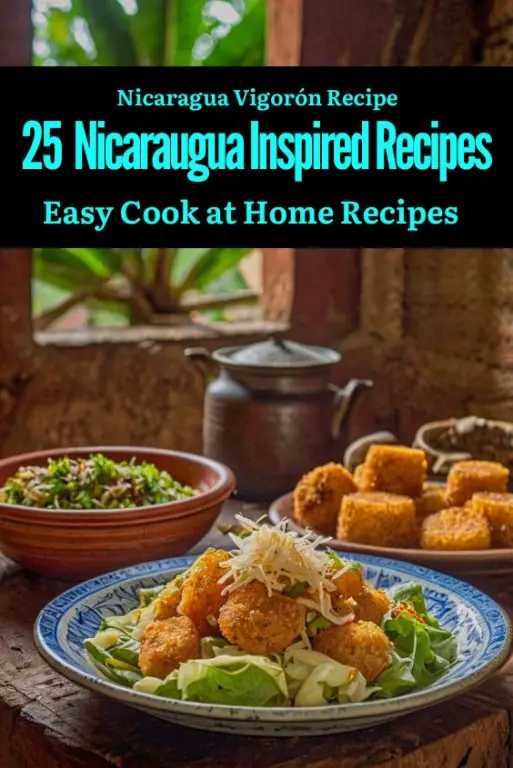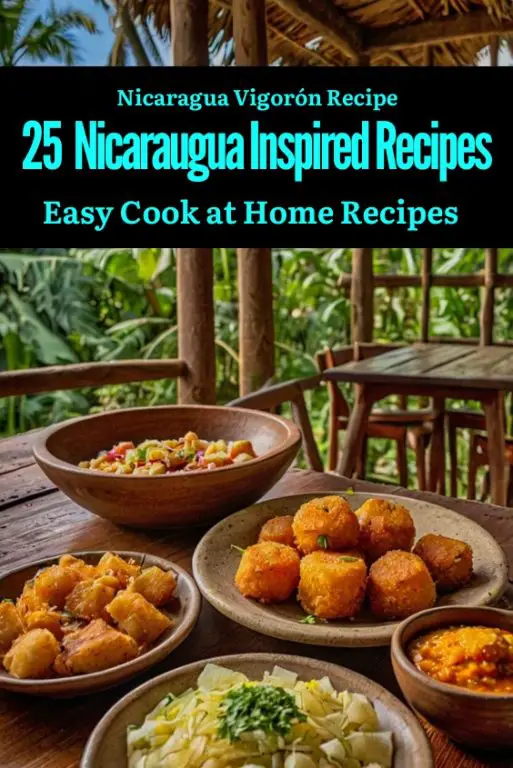The Nicaraguan Vigorón recipe has been one of my favorite Nicaraguan dishes, thanks to its mix of textures and flavors. This snack highlights some of the contrasts in traditional Central American cuisine. With its creamy yuca, crunchy cabbage slaw and crispy chicharrones, Vigorón is food and an experience that reflects Nicaraguan culture at its core. Each layer of this particular dish provides something unique, and I can appreciate exactly how these ingredients combine to create a tasty meal.
First up, yuca (cassava). This starchy root vegetable is the base of Vigorón. I use frozen yuca for convenience but if you can get fresh yuca that’s better. The yuca is mildly sweet and very tender when cooked. In this recipe I cook the yuca in warm water and a bit of vinegar. This method makes it sweet and balances the other ingredients. When it is ready, I drain it and put it on a platter, generously seasoning with pepper and salt.
While the yuca is cooking, I make the slaw. I shred green cabbage and soak it in cool water for ten minutes. This keeps the cabbage crisp and refreshing. After that I create an easy vinegar dressing using lime juice, salt, and black pepper. I pour this colorful mixture over the drained cabbage and toss it until the cabbage is coated. The tangy dressing cuts through the richness of the yuca.
The final touch comes courtesy of chicharrones, the fried pork cracklings that add a salty crunch to the mix. I like to use Mambi brand chicharrones which you can find in Latin American markets. I chop them into bite-size pieces to sprinkle over the slaw and the yuca. Along with these crispy bits, I add some finely diced tomatoes for color and fresh flavor.
The magic happens as you assemble Vigorón. I lay the gentle seasoned yuca on a plate, spoon the crunchy cabbage salad over it, and top with the chicharrones and tomatoes. Each ingredient plays its part, and the presentation whets the appetite. When I dig in, I savor creamy, crunchy and crisp textures with vibrant, spicy and savory tastes.
Vigorón is a popular street food in Nicaragua, eaten as a snack or light meal. When I eat it, I think of Nicaraguan streets and markets. Whether you want to sample Nicaraguan culture or need a new dish to brighten your day, Vigorón is a must try. I promise you will not soon forget this mouthwatering combination of flavors.
Ingredients For the Nicaraguan Vigorón Recipe
Yuca (Cassava)
Pork Belly
Vegetable Oil
Shredded Cabbage
Diced Tomatoes
Thinly Sliced Red Onion
Vinegar
Dried Oregano
Slices of Lemon
Pork Cracklings (Chicharrones)
Salt
Cooking Instructions For the Nicaraguan Vigorón Recipe
- Peel the yuca and cut it into 2-inch chunks.
- In a large pot, bring water to a boil and add salt. Cook the yuca until tender, 20-30 minutes. Drain and set aside.
- In another pot, add the pork belly and enough water to cover it. Bring to a boil and cook for about 40 minutes or until the pork is tender. Remove from the pot and let it cool.
- Once cooled, slice the pork belly into thin pieces.
- Heat vegetable oil in a skillet over medium heat. Fry the sliced pork belly until crispy and golden brown. Remove from heat and set aside.
- In a bowl, combine the shredded cabbage, diced tomatoes, and sliced red onion. Add vinegar, salt, and dried oregano. Toss to combine.
- To assemble the dish, place a portion of cooked yuca on a plate. Top it with a serving of the cabbage mixture and a few slices of crispy pork belly.
- Garnish with a slice of lemon and a tablespoon of pork cracklings (chicharrones) on top.
- Serve and enjoy!
Most Popular Spices For Nicaraguan Cooking
Nicaraguan cooking is known for its flavorful and aromatic dishes, often crafted using a range of spices that enhance the natural ingredients like rice, beans, and plantains. While Nicaraguan cuisine is not as heavily spiced as some other Latin American traditions, it does incorporate key spices that bring depth to the food without overpowering its simplicity. One of the most commonly used spices is cumin. Its earthy, warm flavor is added to dishes like gallo pinto stews, and marinades for meats such as gallo en achiote(chicken in annatto sauce). Cumin enhances the natural richness of the ingredients and pairs well with the region’s staple grains and vegetables.
Annatto (achiote)is another essential spice in Nicaraguan cooking. Annatto seeds are ground into a paste or powder, often mixed with oil, and used to color and flavor dishes. Its mildly sweet and peppery taste is common in marinades, soups, and rice dishes, giving food a vibrant orange hue. Achiote is central to dishes like nacatamales where it provides not only flavor but also the iconic deep red color that makes the dish visually striking.
Garlicis also a fundamental spice used across Nicaraguan dishes. Though technically an aromatic, garlic’s widespread use in marinades, sauces, and stews makes it indispensable in Nicaraguan kitchens. It is often combined with onions, bell peppers, and tomatoes to form the base of many traditional dishes, contributing to the overall depth of flavor. Garlic is particularly prominent in recipes like vigorónand carne asada adding a robust and savory element.
Lastly, oreganoand thymeare commonly used herbs in Nicaraguan cuisine. Oregano brings a slightly bitter, aromatic note that complements meats and stews, while thyme provides a subtle yet distinctive herbal flavor. Both are used in combination with other spices to marinate chicken, pork, and beef, contributing to the complex layers of flavor found in Nicaraguan food.
Together, these spices create the foundational flavors of Nicaraguan cuisine, bringing warmth, depth, and color to the country’s beloved dishes. While the use of spices is generally restrained, their careful application enhances the natural ingredients, making Nicaraguan food both simple and flavorful.
10 Reasons I Love Nicaraguan Food
Nicaraguan food is a unique blend of indigenous traditions, Spanish influence, and a touch of Creole flair. It’s rich in history and flavor, making it a joy to explore. Here are 10 reasons why I love Nicaraguan food:
1. Gallo Pinto – The Staple of Every Meal
Gallo pinto, a simple combination of rice and beans, is served at almost every meal in Nicaragua. Its versatility is impressive; it can be enjoyed for breakfast with eggs and cheese or served as a side dish for lunch or dinner. The subtle flavor of fried beans mixed with perfectly cooked rice makes this dish a comforting and satisfying part of Nicaraguan cuisine.
2. Fresh and Local Ingredients
Nicaraguan cuisine is deeply connected to the country’s agricultural roots. Fresh fruits, vegetables, and meats are widely used, meaning most dishes are made from locally sourced, organic ingredients. This focus on fresh produce brings out the natural flavors of the food.
3. Corn-Based Dishes
Corn is a staple in Nicaraguan food, found in dishes like tortillas, nacatamales, and atol. Whether it’s the thick, handmade tortillas or the masa used in nacatamales, the richness of corn is evident in many traditional meals, providing a hearty base for various dishes.
4. Tasty Street Foods
Nicaraguan street food is diverse and delicious. From quesillo, a tortilla filled with soft cheese, onions, and cream, to vigorón, a mix of yucca, cabbage slaw, and pork rinds, the variety of quick, flavorful snacks is endless. Street food allows you to experience authentic Nicaraguan flavors on the go.
5. Balanced Use of Spices
Nicaraguan cuisine isn’t overly spicy, but it has just the right amount of seasoning. Spices like cumin, garlic, and annatto provide depth and warmth without overwhelming the dish. This balanced approach allows the natural flavors of the ingredients to shine through, making the food flavorful but not too intense.
6. Plantains Everywhere
Plantains are an essential part of Nicaraguan food, served in various forms like tostones (fried green plantains) or tajadas (fried ripe plantains). Their sweetness and starchiness complement savory dishes, adding a unique flavor and texture to meals.
7. Comforting Stews and Soups
Nicaraguan stews and soups, such as sopa de res (beef soup) and mondongo (tripe soup), are hearty and full of flavor. These dishes are often slow-cooked with vegetables and spices, resulting in rich, comforting broths that are perfect for any time of the year.
8. Nacatamales – A Celebration Food
Nacatamales are a Nicaraguan version of tamales, made with corn masa stuffed with pork or chicken, rice, potatoes, and spices, then wrapped in banana leaves and steamed. This dish is traditionally served during special occasions and holidays, making it a beloved comfort food. The combination of textures and flavors is unique, with the banana leaf adding a subtle earthy taste to the masa.
9. Delicious Desserts
Nicaraguan desserts, like tres leches cake and arroz con leche, are indulgent and satisfying. Tres leches cake, in particular, is a crowd favorite, with its sponge cake soaked in three kinds of milk, resulting in a rich, moist treat. The sweetness and creaminess of Nicaraguan desserts make them the perfect end to any meal.
10. A Blend of Cultures
Nicaraguan food is a beautiful mix of indigenous, Spanish, and Creole influences, which creates a rich culinary tapestry. From the indigenous use of corn to the Spanish introduction of rice and pork, the fusion of flavors and techniques makes Nicaraguan cuisine both diverse and uniquely flavorful.
Nicaraguan food is rich, comforting, and deeply connected to the country’s culture and history. Whether it’s the simplicity of gallo pinto or the complexity of nacatamales, each dish tells a story and offers a taste of Nicaragua’s diverse culinary heritage. From fresh, local ingredients to the balanced use of spices, these 10 reasons are just the beginning of why I love Nicaraguan food.
FAQ For the Nicaraguan Vigorón Recipe
Q: What are the main ingredients in a Nicaraguan Vigorón recipe?
A: A Nicaraguan Vigorón recipe typically includes boiled yuca (cassava), a refreshing cabbage salad, and chicharrón (fried pork cracklings). The yuca is usually cooked until tender and then served as a base for the dish. The cabbage salad is often seasoned with lime juice, adding a zesty flavor that balances the richness of the chicharrón. Overall, the Nicaraguan Vigorón recipe combines these elements to create a hearty and flavorful meal that showcases traditional Nicaraguan ingredients.
Q: Is the Nicaraguan Vigorón recipe difficult to make?
A: The Nicaraguan Vigorón recipe is relatively simple to prepare, making it accessible for home cooks. While there are a few components to the dish, such as boiling yuca and frying chicharrón, the process is straightforward. Many people find that preparing the cabbage salad is quick and easy, requiring only a few ingredients and minimal chopping. Overall, the Nicaraguan Vigorón recipe is manageable for both novice and experienced cooks, offering a delicious payoff for the effort.
Q: Can the Nicaraguan Vigorón recipe be made vegetarian or vegan?
A: Yes, the Nicaraguan Vigorón recipe can be adapted to be vegetarian or vegan by replacing the chicharrón with plant-based alternatives. Options like sautéed mushrooms or crispy tofu can mimic the texture and provide a savory element to the dish. The yuca and cabbage salad remain the same, maintaining the essential components of the recipe. This makes it easy for those following a plant-based diet to enjoy the flavors of the Nicaraguan Vigorón recipe without compromising their dietary preferences.
Q: What are common variations of the Nicaraguan Vigorón recipe?
A: Common variations of the Nicaraguan Vigorón recipe may include different toppings for the cabbage salad, such as tomatoes, onions, or avocado. Some regions might incorporate additional seasonings or dressings, like vinegar or hot sauce, to enhance the flavor profile. Additionally, while chicharrón is traditional, some versions use grilled meats or fish instead. These variations allow for creativity while still honoring the original elements of the Nicaraguan Vigorón recipe, making it versatile for different tastes.
Q: How is the Nicaraguan Vigorón recipe typically served?
A: The Nicaraguan Vigorón recipe is often served as a hearty street food dish, usually plated on a banana leaf or in a bowl. The boiled yuca forms the base, topped with the vibrant cabbage salad and generous portions of chicharrón. It’s commonly enjoyed as a main meal but can also be served as an appetizer or snack during gatherings. The Nicaraguan Vigorón recipe’s presentation is colorful and inviting, making it a popular choice for sharing with family and friends.

Nicaraguan Vigorón Recipe
Equipment
- Large pot: Used to cook the yuca until tender.
- Frying pan: Used to fry the pork rinds until crispy.
- Mixing bowl: Used to combine the cabbage slaw ingredients.
- Serving platter: Used to present the Vigorón dish.
Ingredients
- 2 pounds yuca cassava
- 2 pounds pork belly
- 2 tablespoons vegetable oil
- 4 cups cabbage shredded
- 2 cups tomatoes diced
- 1 cup red onion thinly sliced
- 1 cup vinegar
- 1 teaspoon dried oregano
- 8 slices of lemon
- 8 tablespoons pork cracklings chicharrones
- Salt to taste
Instructions
- Peel the yuca and cut it into 2-inch chunks.
- In a large pot, bring water to a boil and add salt. Cook the yuca until tender, 20-30 minutes. Drain and set aside.
- In another pot, add the pork belly and enough water to cover it. Bring to a boil and cook for about 40 minutes or until the pork is tender. Remove from the pot and let it cool.
- Once cooled, slice the pork belly into thin pieces.
- Heat vegetable oil in a skillet over medium heat. Fry the sliced pork belly until crispy and golden brown. Remove from heat and set aside.
- In a bowl, combine the shredded cabbage, diced tomatoes, and sliced red onion. Add vinegar, salt, and dried oregano. Toss to combine.
- To assemble the dish, place a portion of cooked yuca on a plate. Top it with a serving of the cabbage mixture and a few slices of crispy pork belly.
- Garnish with a slice of lemon and a tablespoon of pork cracklings (chicharrones) on top.
- Serve and enjoy!





1 comment
I tried the Nicaragua Vigorón Recipe for the first time, and it was an interesting and refreshing dish. The combination of yuca, cabbage slaw, and pork cracklings was a unique blend of textures.